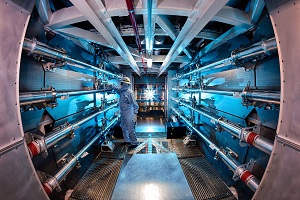A key step on the way to ignition at NIF is for the energy generated through fusion reactions to exceed the amount of energy deposited into the deuterium-tritium (DT) fusion fuel-a condition known as "fuel gain." This has never before been achieved in a laboratory fusion plasma.
An article by LLNL researcher Omar Hurricane and colleagues in the February 12 online issue of Nature reports that through the use of a new implosion process developed over the past few months, fusion fuel gains exceeding unity have been achieved for the first time on any facility.
The experiments show an order-of-magnitude improvement in yield performance over previous NIF shots, as well as a significant contribution to the yield from alpha-particle self-heating, in which the alpha particles (helium nuclei) produced in the fusion process deposit their energy in the DT fuel. The alpha particles further heat the fuel, increasing the rate of fusion reactions, thus producing more alpha particles. This "bootstrapping" process is the mechanism required to accelerate the DT fusion burn rate to eventual self-sustaining fusion burn and ignition.
These recent experiments use a higher initial laser pulse than previous shots, and have become known as the "high foot" design approach. NIF laser pulses are carefully shaped over their few-nanosecond duration to ensure that the implosion is efficient and robust. The "high foot" approach uses a shorter pulse duration and three laser shocks on the target, rather than four. This configuration is designed to reduce hydrodynamic instability growth in the imploding fuel pellet. This helps to inhibit contamination of the DT fusion fuel by the plastic capsule material, which would otherwise "quench" the fusion process and prevent it from burning.
Most importantly, these latest results show good agreement between the experimental data and the computer models used to predict the performance. This is in comparison to prior experiments, where an order of magnitude discrepancy was often seen. Such agreement now provides a more robust platform with which to explore the path for future advances towards ignition. Ignition-defined to be when a megajoule of fusion energy is released-is a threshold process and needs exquisite control of the initial conditions and plasma evolution during the implosion.
Progress made since the experiments reported in Nature have shown further significant improvements in fusion output, with more experiments planned for later this year.

__________________

Dr. Mike Dunne is program manager for Laser Fusion Energy at Lawrence Livermore National Laboratory



